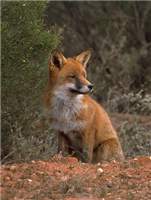Family
CanidaeGenus
Vulpes
Species
vulpes
Threats/Control Methods - Regional
Growth in fox population is discouraged in Australia since fox's play a major role in reducing populations of native animals. Under the EPBC Act 1999, predation by the fox is listed as a 'key threatening process'. Ground dwelling species are particularly susceptible to attacks, however foxes are also a threat to arboreal marsupials, moving between ground and tree habitats. Fencing and broadscale fox control with poison baits has been used successfully in some areas, allowing populations of some native mammals to begin to recover and return to former habitats. Currently, the National Threat Abatement Plan seeks to recover populations of native species through improving the effectiveless of control methods, the knowledge surrounding fox predation and cooridating fox control activities. Scientists are investigating ways to improve conventional fox control methods to make them more effective and humane, and less likely to harm non-target animals. New biological control techniques are also being investigated. These include a vaccine to prevent pregnancy.
Threats/Control Methods - Local
In the Canberra region, the Ringtail Possum (Pseudocheirus peregrinus ) is at threat from fox predation.
Local/Urban Actions
Urban foxes will rarely attack people. However, they are wild animals and should not be approached, unless by a trained authority.Common name/s
European Red Fox, Red Fox, Fox
Distinguishing Features
Foxes have red-brown coloured fur, pointed muzzles, flattened slender skulls, large ears and long bushy tails. Their belly and throat are light-coloured blend of white and grey. The length of their head and body is about 60-70cm and their tails are about 40cm long. Their body weight is 4.5-8 kg.
Species Call
" Young foxes use aggressive yapping and a resonant howl in winter. " Vixens and pups will bark and whimper softly" Adult foxes also scream.
Similar Species
Wild Dogs and Dingoes (Canis lupus) are similar, but much larger species.
Distribution
The fox is found throughout all of mainland
Country of Origin
The United Kingdom. It was deliberately introduced into
Survey Techniques
The fox was identified using many techniques during the day and night, including searches, scats, sandplots and calls.
Conservation (Pet/Pest) Status - National
Introduced Species, common.
Conservation (Pet/Pest) Status - Regional
Common
Associated vegetation community
Foxes thrive in a variety of habitats, including alpine, arid, and urban areas. Generally, foxes inhabit remnant bushland or park areas, and will also shelter under the platforms of suburban railway stations or in dens built under floorboards of houses or sheds. In rural Australia, foxes are more abundant in patchy landscapes of native bushland and agricultural land.
Limiting Resources
In urban areas, the distribution of foxes will depend on the availability of a food supply and shelter. They prefer fragmented environments, as they offer a wide variety of cover, food and den sites.
Breeding
Females breed only once in the annual fox breeding season, which runs from July to October in south-eastern Australia. Both males and females are sexually mature at the age about ten months. Litters, averaging four cubs, are born during August and September, and emerge from the den in late spring. The cubs move away from the family territory in late summer or autumn.
Behaviour
Foxes are nocturnal and spend most of the day resting in dens, logs and other shelters. Previously, foxes were thought to be solitary, but recent evidence suggests that the fox society is far more complex. A fox's range can extend to more than five square kilometres and in urban areas population densities can be as high as 12 adults per square kilometre. Studies have shown that in some cases foxes may live in groups of one adult male and several vixens (females).
Functional Group
Omnivore, though mostly carnivorous.
Food Species
Foxes are mainly carnivorous, preying on a range of small animals. In Australia where rabbits are common, they make up about 40% of the fox's diet. They also take insects and fruits, carrion, frogs, birds, mice, and possums. In some cases foxes may even disturb or kill domestic pets, poultry and other farm animals. In urban areas foxes will scavenge anything they can find and raid rubbish bins.
Predators
Dingos and Wild Dogs are larger and stronger, with the ability to attack and kill foxes.
Interesting Fact
While foxes are considered dangerous predators, some research shows that the removal of foxes from an environment may not directly lead to the increase of native wildlife.
References - (reader suitability of references, P=Primary teachers, S=Secondary students, T=Tertiary students and researchers)
Books:Straham, R. (ed.) 1983. The Australian Museum Complete Book of Australian Mammals. The National Photographic Index of Australian Wildlife. Angus and Robertson Publishers. Sydney. P, S, T
Online Publications:Department of Environment and Heritage. 2004. European Red Fox (vulpes vulpes). [online]. Available at: http://www.deh.gov.au/biodiversity/invasive/publications/fox/. P, S, T
NSW National Parks and wildlife Services. 1999. Fox control in wildlife habitat . Fact Sheet. Note 4. [online]. Available at: www.nationalparks.nsw.gov.au/PDFs/Factsheet4_Fox_control.pdf S, T
NSW Parks and Wildlife Service. 2001. Threat Abatement Plan for Predation by the Red Fox (Vulpes vulpes). NSW Parks and Wildlife Service. Hurstville. S, T
Tidemann, C., Roscoe, T. and Mitchell, B. 2006. Mammals of the Lower Sullivans Creek Catchment, Canberra ACT. Prepared for the Life in the Suburbs project using data from the Lower Sullivans Creek Catchment Ecological Survey (LSCCES). Australian National University. Canberra. [online]. Available at: http://www.lifeinthesuburbs.com.au/category.php?id=65 S, T
Researchers: Hedda Ranson-Elliott and Naomi Hogan

 Top
Top Top
Top